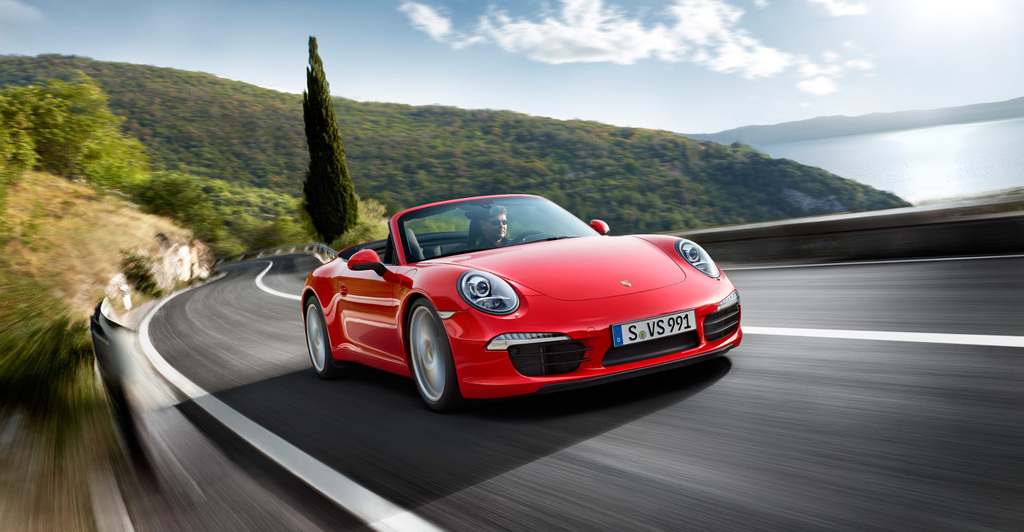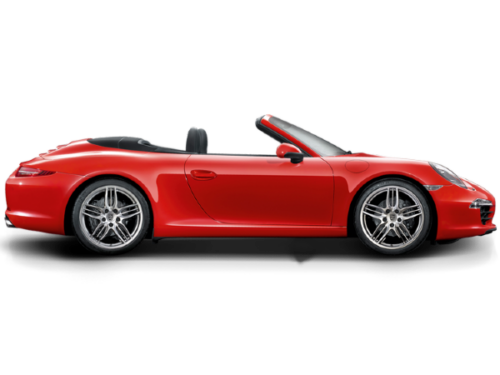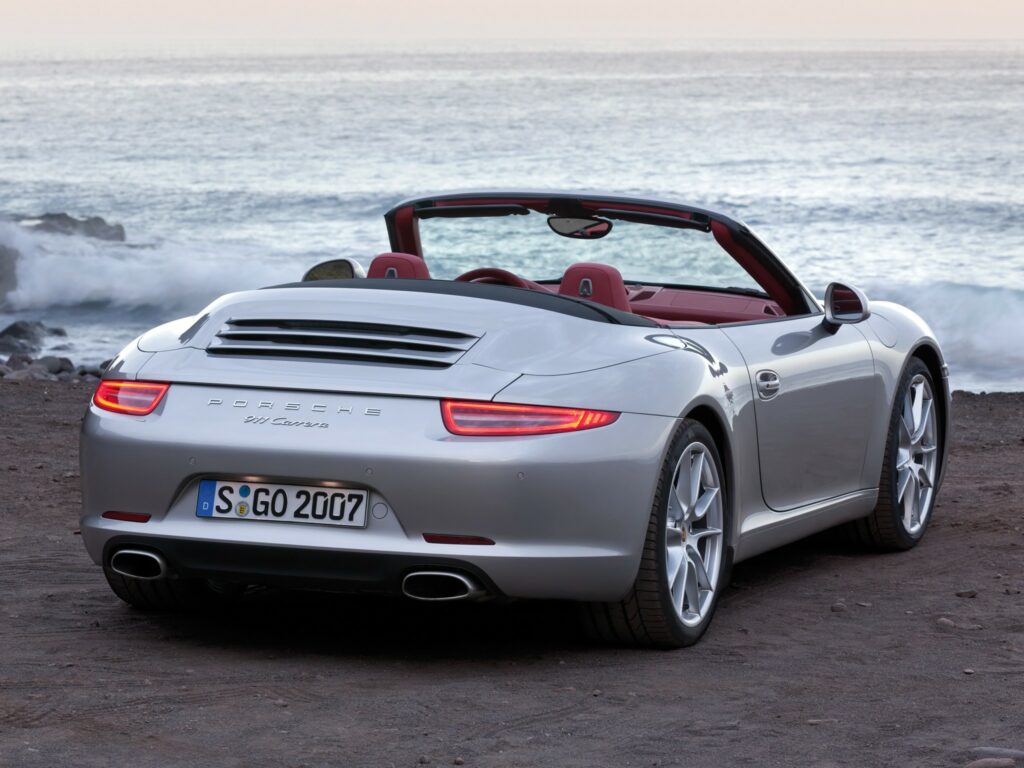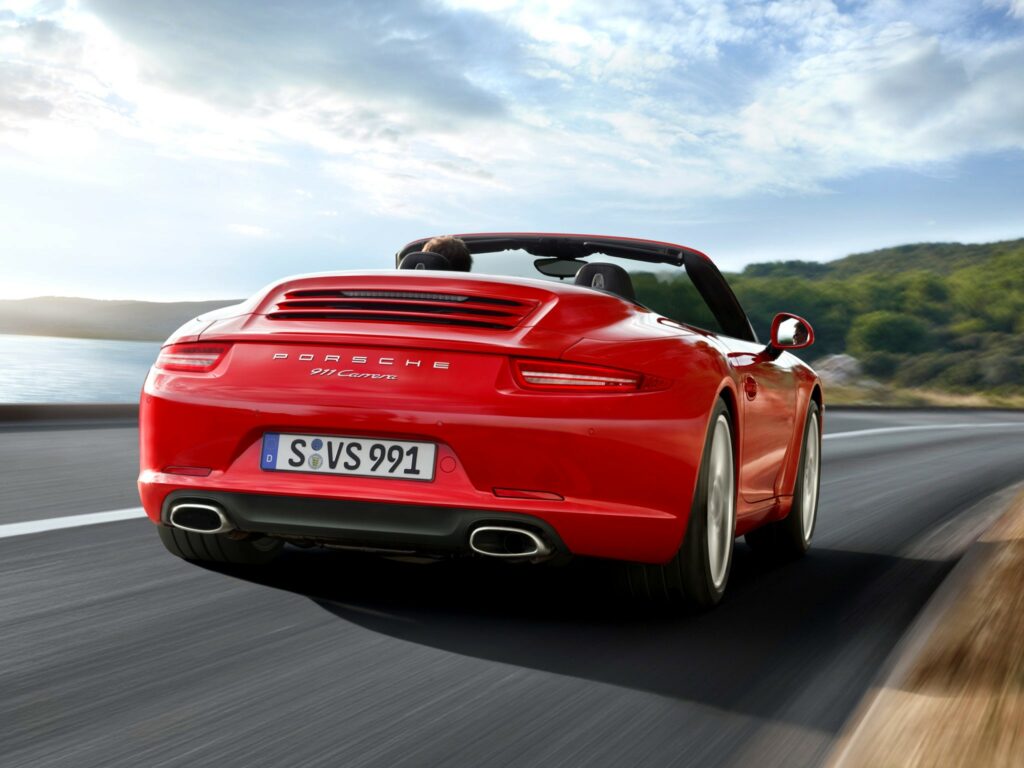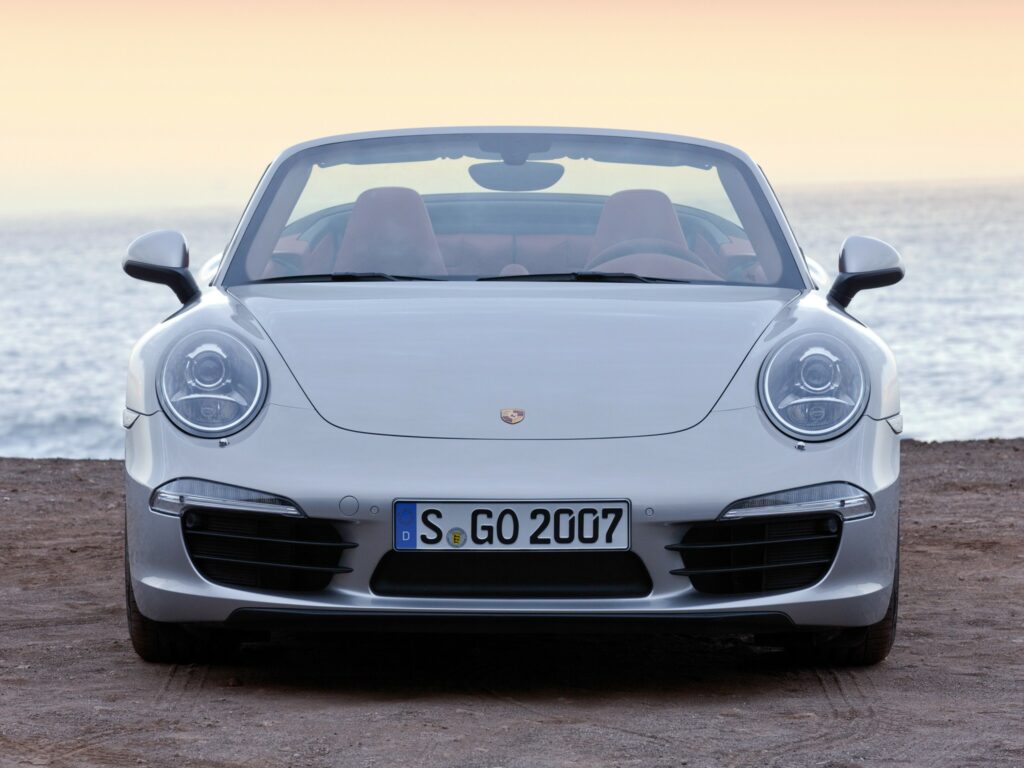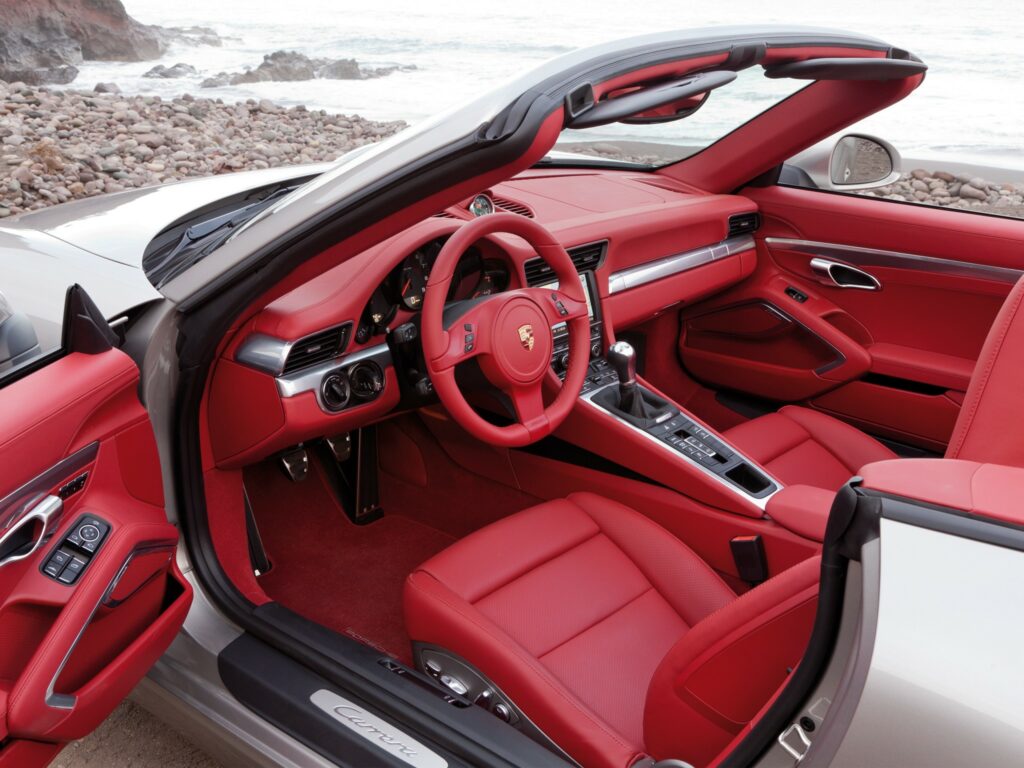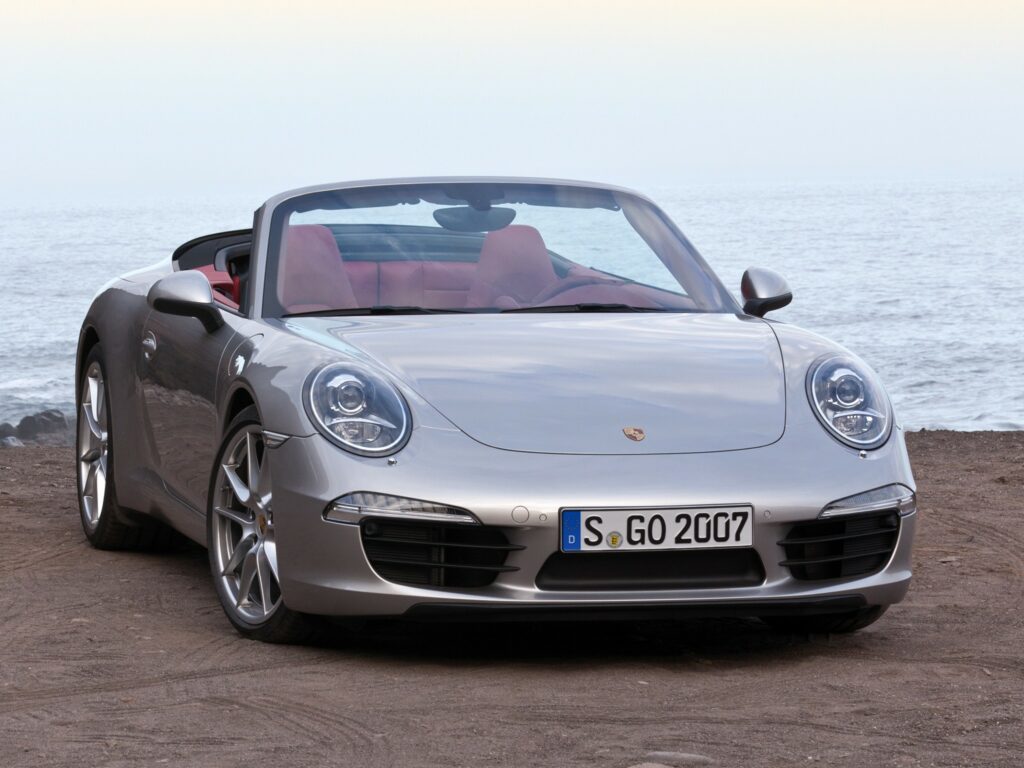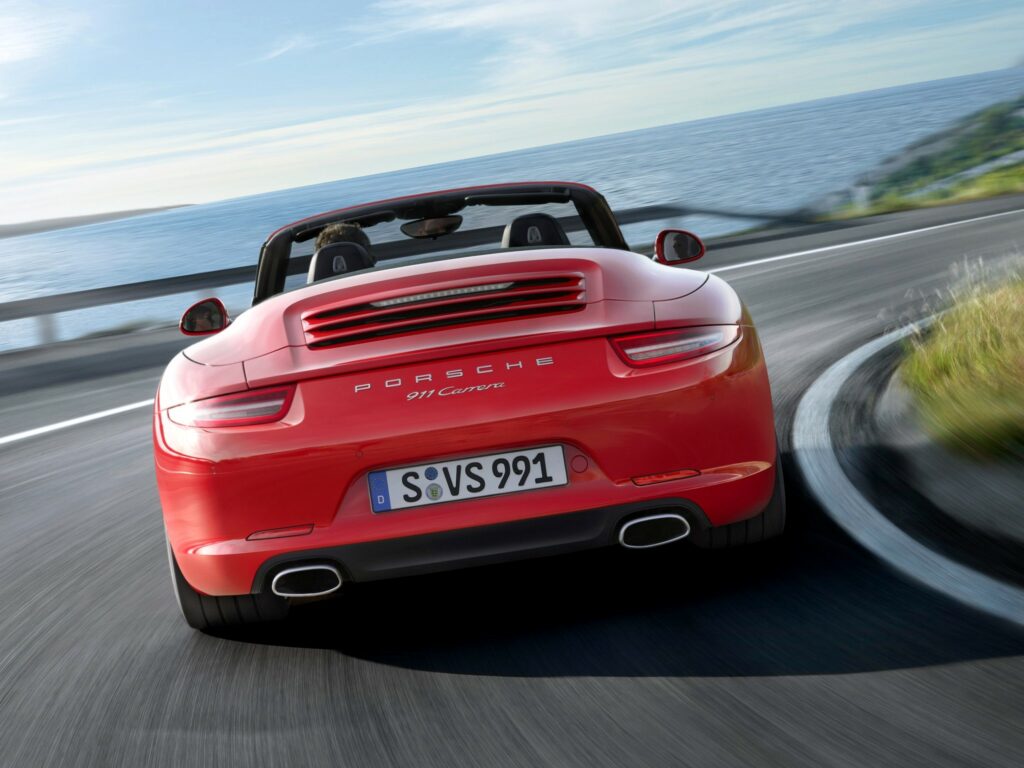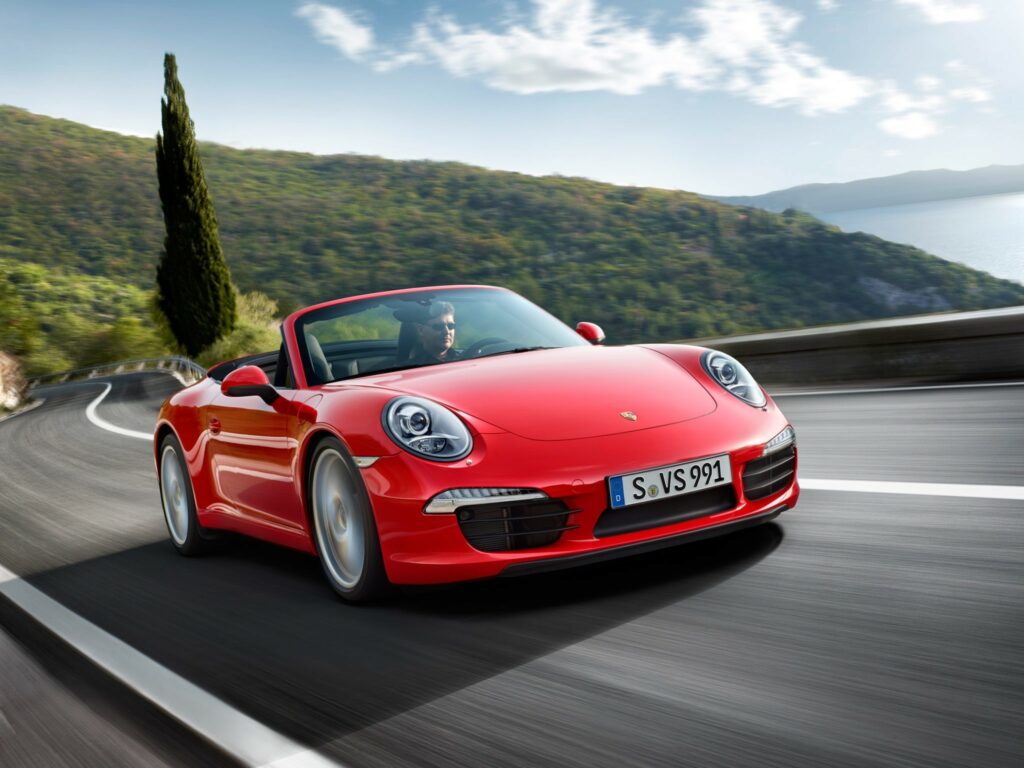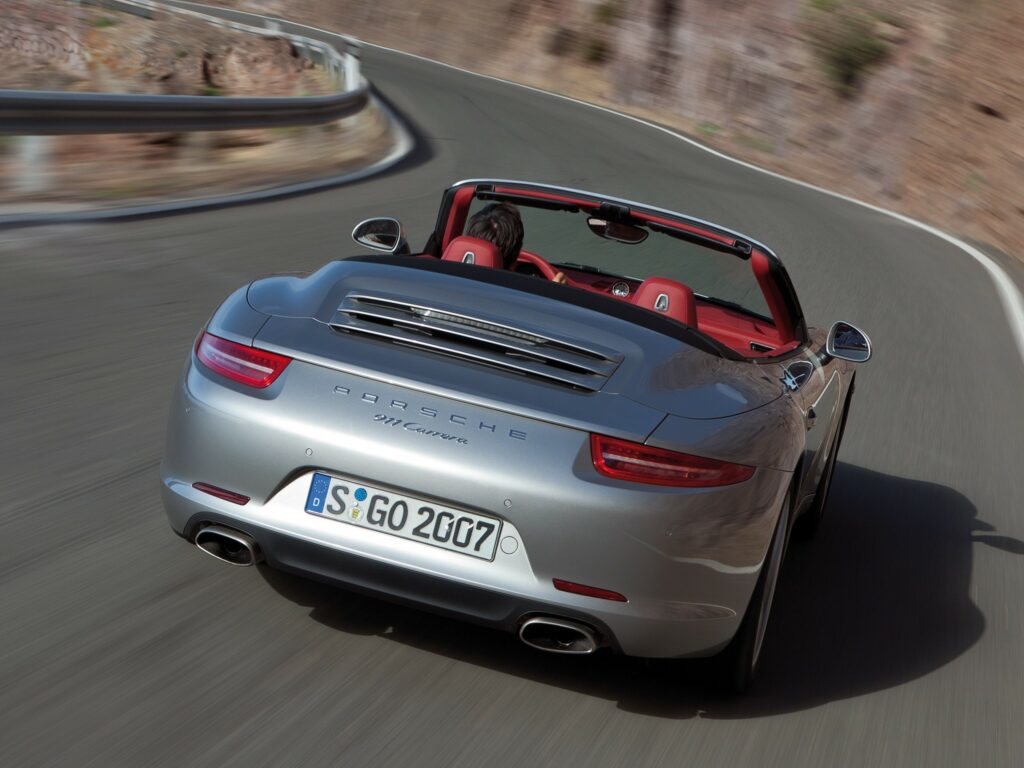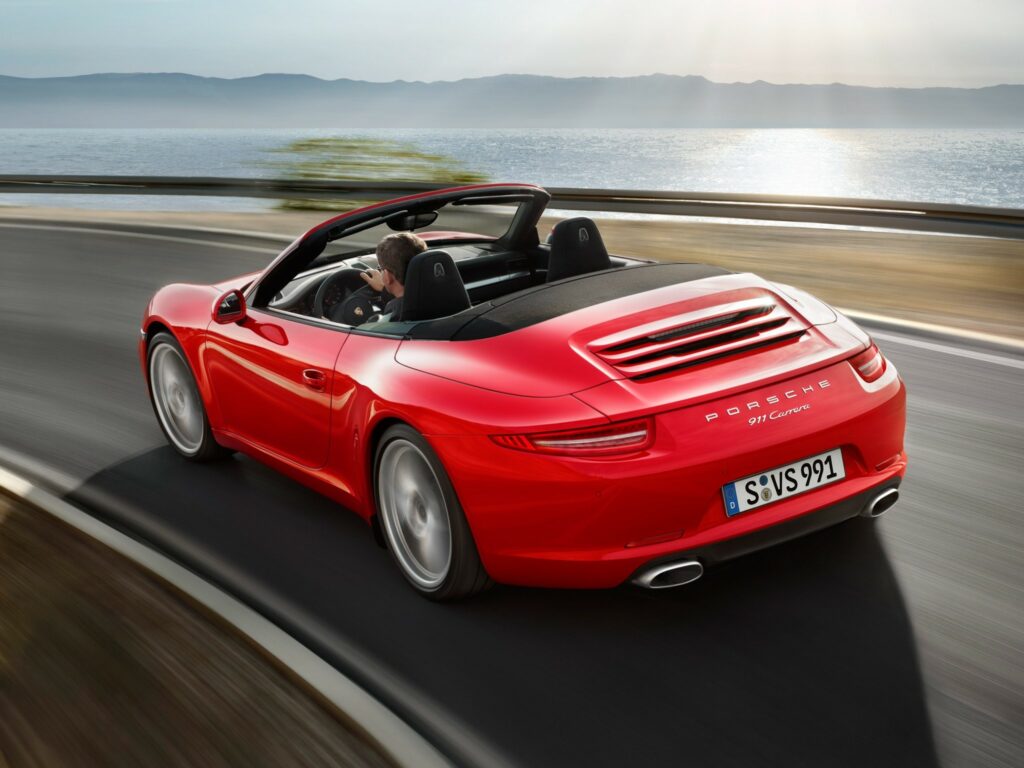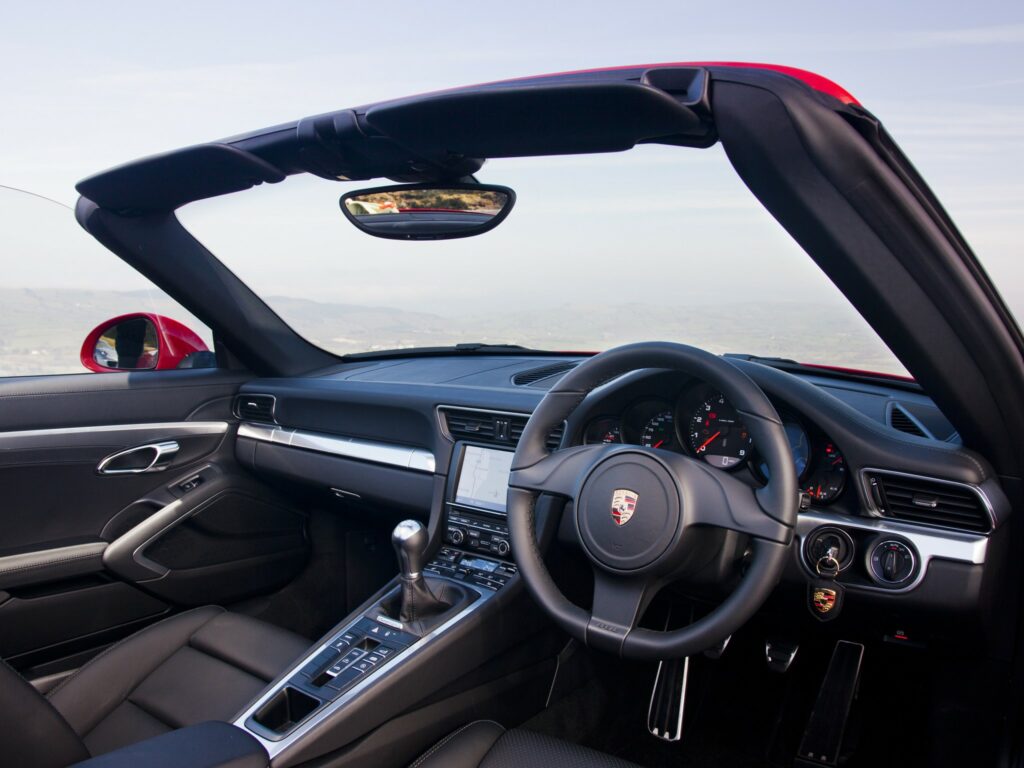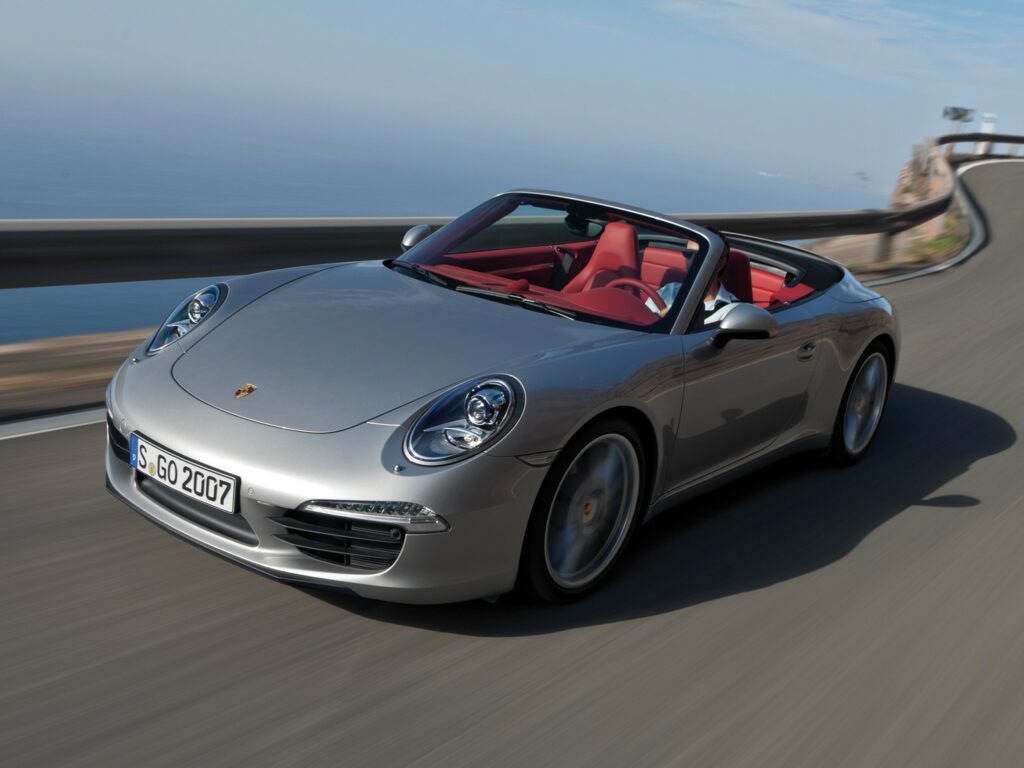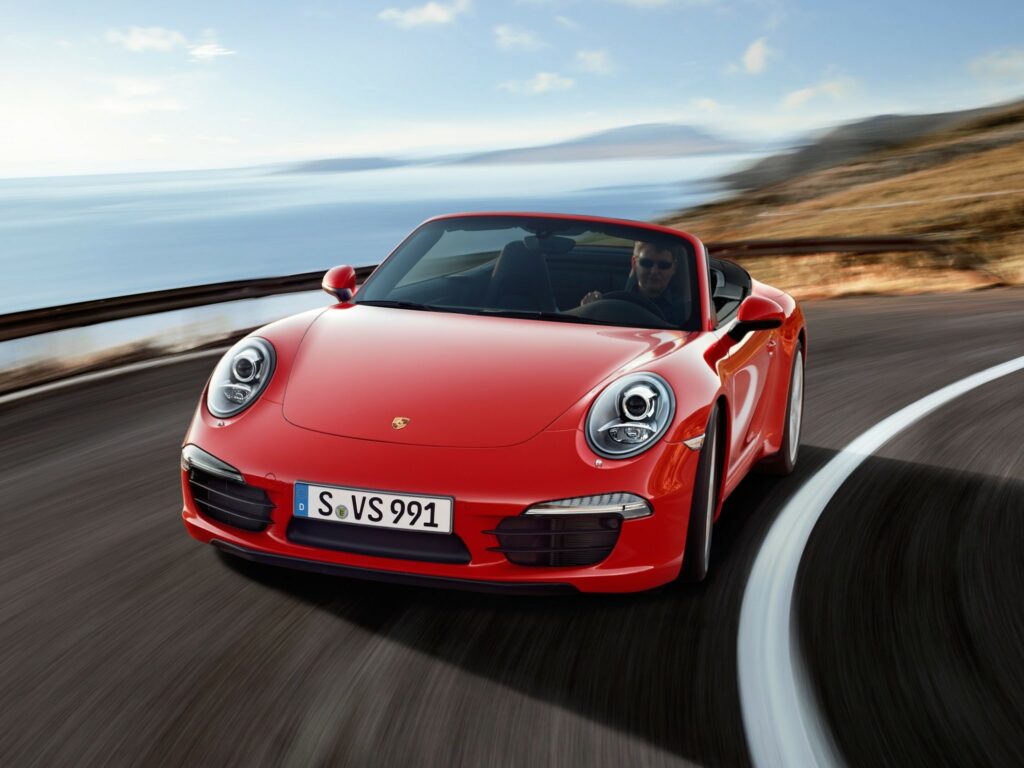(2012 – 2015) Porsche 911 Carrera Cabriolet (991) – Ultimate Guide
Porsche is doubling the driving fun to be had from the new 911 Carrera by putting a Cabriolet alongside the Coupé. The debut of the new generation of the sports car classic is being followed only a few months later by the open-top models of the 911 Carrera and 911 Carrera S in the new 911 design.
What the Coupé began with the new aluminium-steel body, the Cabriolet continues with the all-new, unique hood: As a result, the typical 911 roof line is initially retained in its entirety. Even when closed up, the Cabriolet cuts a fine figure. Intelligent lightweight design, even including the use of magnesium in the hood, ensures less weight and more sportiness, lower fuel consumption and greater comfort. With the open-top 911s as well, Porsche has managed to reverse the weight spiral and make the new Cabrio models significantly lighter than its predecessors.
The 991 structure had to be stiffened slightly when the top got chopped, mainly around the B-pillar area, rockers, and windshield frame. As a result, cowl shake is nonexistent. A fully electric wind deflector that deploys at the push of a button adds some more weight, as does the top itself, but the convenience is well worth the penalty. (The automatic deflector integrates seamlessly with the rear shelf when retracted.) Overall, the 991 convertibles weigh about 132 fewer pounds on a model-to-model basis than the 997s they replace.
Complementing the convertible’s straight-line prowess is its adept ability at tackling corners. The suspension consists of struts in the front and a multilink setup in the rear. The ride is firm, as you’d expect; as in the coupe, Porsche’s dynamic shocks, better known as Porsche Active Suspension Management, are standard on the S and optional ($2090) on the Carrera.
Each of the two new Cabriolets has the same engine as its Carrera Coupé equivalent. The rear of the 911 Carrera Cabrio houses a 3.4-litre flat engine generating 350 hp (257 kW) of power driving the rear wheels through a seven-gear manual transmission. The open-top Carrera S comes with a 3.8-litre six-cylinder engine developing 400 hp (294 kW) and also a seven-gear manual transmission featured as standard.
That means that the open-top 911s as well are distancing themselves even further from the competition in terms of efficiency; both models consume less than ten litres of fuel per 100 kilometres (NEDC). The Cabriolets as well have the Porsche Doppelkupplungsgetriebe (PDK) available as an optional extra, delivering even lower fuel consumption and shorter acceleration times.
- Autoweek said: Overall, the 2012 Porsche 911 Carrera Cabriolet is a well-done piece. Solid chassis, great engine (though the extra power in the S model would be nice) and not bad with the top dropped. It’s definitely on my fun-to-drive list now.
With the longer wheelbase compared with the predecessor model, the wider front track and the new electro-mechanical power steering, the new Cabriolets offer even sportier driving characteristics, greater precision and agility. Depending on model, there are other standard or optional active control systems available as well that further enhance the driving dynamics.
The 911 Carrera Cabriolet will be launched in Germany on March 3, 2012. The prices for the 911 Carrera Cabriolet start in Germany with 100,532 Euros, the 911 Carrera S Cabriolet starts with 114,931 Euros including value-added tax in both cases.
Car and Driver: All these chassis technologies make attacking a mountain road a snap. (We’ll give you a moment here to again weep for the unassisted, undiluted, widow-making 911s of the past. As well as their owners.) You can explore the cabriolet’s limits without much fear, particularly with the stability-control intervention reduced in sport-plus mode, a setting that livens throttle response on both manual and PDK transmissions; it also modifies shift patterns for the latter.
Pictures
Press Release
The sky’s the limit now for driving fun with the new Porsche 911 Carrera Cabriolet which follows the Coupé introducing the superior attributes of the new generation 911 in the open-top sports car market segment. What the Coupé began with the new aluminium-steel body, the Cabriolet continues with the all-new, unique hood: intelligent lightweight design, even including the use of magnesium in the hood, ensures less weight and more sportiness, lower fuel consumption and greater comfort.
At the same time, the new convertible top technology enables the typical 911 roof line to be retained in full for the first time: even with the top closed, the Cabriolet reveals the unmistakable 911 silhouette – never before were Cabrio and Coupé so similar.
Each of the two new Cabriolets has the same engine as its Porsche 911 Carrera Coupé equivalent:
- Porsche 911 Carrera Cabriolet – 3.4-litre boxer engine with 350 hp (257 kW); rear-wheel drive, seven-speed manual transmission, optional seven-speed Porsche-Doppelkupplungsgetriebe (PDK); acceleration zero – 100 km/h in 5.0 seconds, with PDK in 4.8 seconds (4.6 seconds with Sport Chrono Package); top speed 286 km/h, with PDK 284 km/h; fuel consumption (NEDC) 9.2 l/100 km, CO2 217 g/km; with PDK 8.4 l/100 km CO2 198 g/km.
- Porsche 911 Carrera S Cabriolet – 3.8-litre boxer engine with 400 hp (294 kW); rear-wheel drive, seven-speed manual transmission, optional seven-speed Porsche-Doppelkupplungsgetriebe (PDK); acceleration zero – 100 km/h in 4.7 seconds, with PDK in 4.5 seconds (4.3 seconds with Sport Chrono Package); top speed 301 km/h, with PDK 299 km/h; fuel consumption (NEDC) 9.7 l/100 km, CO2 229 g/km; with PDK 8.9 l/100 km CO2 210 g/km.
The new Cabriolets are the 911s with emotional appeal. With the top down, they convey a unique abundance of intense driving impressions between outstanding performance and calm comfort. This is based on the light, stiff body in conjunction with the long wheelbase. Reduced weight and a longer wheelbase compared with the predecessor generation are complemented by the wider front track and larger wheels. In terms of its performance, the new 911 Cabrio raises the bar not by an inch but by a yard. This is down to a precisely synchronised package of new and enhanced systems. Electro-mechanical power steering and, in the case of the Carrera S, Porsche Torque Vectoring with differential lock are featured as standard – in conjunction with PDK even regulated. If so desired, the new 911 Carrera ups the ante in driving dynamics terms with options such as PDCC roll stabilisation.
With the open-top 911s as well, Porsche has managed to reverse the weight spiral and make the new Cabrio models significantly lighter than their predecessors, by up to 60 kilograms depending on equipment. As a result, for the same engine output, the new 911 Carrera generation combines enhanced performance with significantly lower fuel consumption – in short “Porsche Intelligent Performance”.
Innovative lightweight roof with Coupé characteristics
The attention-getter with the Porsche 911 Carrera Cabriolet is the unique and all-new panel bow top. Thanks to the innovative technology, it has been possible for the first time to achieve the previously unachievable Coupé-like roof curvature of the closed fabric top, which offers aerodynamic advantages into the bargain. Moreover, the weight of the entire top remains on a par with the predecessor model, notwithstanding the increased length and signifi cantly enhanced comfort. The top can be opened and closed in approximately 13 seconds respectively – as in the case of the predecessor up to a speed of 50 km/h. It is operated by means of a button on the centre console or, from the outside, by means of the remote control.
Porsche has traditionally set the highest standards for the 911 top. That is why the new folding roof as well – as with every previous 911 – is a completely standalone development. The first distinctive feature is apparent at a glance: the fabric roof is tensioned in an elegant arc from the front window frame to the convertible top compartment with styling that is almost identical to that of the Coupé. No roof bows are discernible under the fabric nor are there any sections that interrupt the flowing design. Even the heatable rear window is virtually flush-fitting thanks to a new technique and is integrated with the cover with only the most discreet of seams.
Porsche new development: lightweight magnesium panel bow top
Critical to this shape, previously unachievable with fabric tops, is the innovative design as a panel bow top. This entails the entire fabric top – with the exception of the side panels – being tensioned over a rigid roof surface comprising four directly abutting individual segments. The four elements are the front roof frame, two panel bows and the rear window, the frame of which is made of magnesium, like the other segments. A large proportion of the frame guides are also made of this very light material; only the lateral guides, the drive levers and the rear tension bow are of aluminium. All frame components are kinematically linked so that only one hydraulic cylinder is required on each side to move the top. When it comes to closing the top, Porsche relies on a refinement of the tried and tested, centrallylocated, electric central locking mechanism, which is supported by lateral centering pins.
The panel bows and top are not locked together so that the four magnesium segments can dovetail one on top of the other when the top is opening whereas the fabric top is stowed using the tried and tested Z-folding technique. Thanks to this unique concept, the roof package comprising the fabric top, roof frame, panel bows and rear window requires only minimal stowage space of approximately 23 centimetres in height and around 55 centimetres in length when in the open position. Whereas the front section of the top remains visible when the top is open, the sickle-shaped flap covers the rear section – as before. Unlike the predecessor model, this significantly enlarged convertible top compartment lid now extends as far as the spoiler. This does away with the need for a body joint, with the rear looking even more elegant as a consequence.
With the top closed, the occupants enjoy a level of climate and noise comfort that comes closer to that of the Coupé than ever before. For example, the exterior material is underlaid over its entire area with an insulating mat. On the inside, the roof segments are covered with dimensionally stable roof linings that convey a comfortable interior feeling. The side panels as well are entirely clad with fabric so that with the hood closed, no technical components are visible any longer. The headroom as well is also broadly the same as inside the Coupé.
New: fully integrated electric wind deflector
A further innovation in the Porsche 911 Carrera Cabriolet is the built-in electric wind deflector. That makes fitting and removal a thing of the past. The new wind deflector is attached to a U-shaped tensioning bracket, which is fully integrated into the rear area when retracted, thereby not encroaching on the available space on the rear seats. At the push of a button, this bracket deploys within two seconds, in the process unrolling a mesh that is tensioned at right angles by a second movable deflection bracket behind the front seat armrests. The wind deflector can be deployed up to a speed of 120 km/h. The effect is equivalent to that in the predecessor model, ensuring that draughts are eliminated to a very large extent and that wind noise is minimal when the top is open. A deployed wind deflector is automatically retracted when the top is closed.
Latest generation adaptive rear spoiler
The Porsche 911 Carrera Cabriolet adopted the Coupé’s variable spoiler concept albeit with modified parameters. With the top closed, the spoiler settings are the same as those of the Coupé, as the new top generates an almost identical airflow. Unlike when the top is open, in which case the spoiler assumes specifically developed positions. Depending on the vehicle configuration, the spoiler also extends to different heights and at different angles. Additionally, a flow element located on the leading edge of the spoiler is controlled by means of a special pivoting kinematic mechanism, ensuring optimal airflow over the spoiler blade. The spoiler is extended automatically at 120 km/h and retracted at 80 km/h but can also be extended below these speed limits at the push of a button.
cd = 0.30: Cabriolet with exemplary aerodynamics
The basic building blocks of the aerodynamic concept for the Porsche 911 Carrera Cabriolet are the streamlined surface of the body, the new top, the variable rear spoiler and the cooling system, which requires no large air intakes on the underside of the vehicle and therefore makes possible a largely smooth vehicle floor. Optimised air intake and air outlet cross sections also improve the guidance of the cooling air so that despite the cooling system that has been upgraded to cope with the enhanced engine and braking performance, the Porsche 911 Carrera Cabriolet’s exemplary cd of 0.30 – with the top closed – remains unchanged.
Open-top lightweight 911 with new design language
The Porsche 911 Carrera Cabriolet’s design echoes its predecessor’s styling while developing an entirely new design language: thanks to a longer wheelbase combined with shorter overhangs, the vehicle makes a compact, made to measure impression. A vehicle height reduced by a further four millimetres (three millimetres in the case of the 911 Carrera S) compared with the 911 Carrera Coupé strikes a distinctly sporty tone in outward appearance. As a result of the 52 millimetre wider front track compared with the predecessor, the Porsche 911 Carrera Cabriolet has an even more solid stance on the road. The vehicle’s 61 millimetre greater width at the front creates an even more harmonious vehicle silhouette. Larger air intakes underneath the redeveloped front lights emphasise the striking appearance. Together with the new Bi-Xenon headlights, they give the Porsche 911 Carrera Cabriolet a distinctive face.
The rear end echoes the sporty looks of the car’s front end. It is characterised in particular by the new wider rear spoiler below the engine lid air intakes. The outer edge of the lid is part of the continuous design edge, which cleverly emphasises the vehicle’s width. The compact dimensions of the redeveloped top system when stowed enabled the space above the engine to be used to best effect. The result: an elegantly flat and harmonious rear section.
Body: even stiffer and up to 60 kilograms lighter
The innovative lightweight body of the 911 Carrera family was redesigned from the ground up for Coupé and Cabriolet alike. That means that the open-top 911 and fixed-roof model share both the weight advantages of the aluminium-steel body and the significantly improved rigidity, complemented by local reinforcement elements. A continuous side impact support strut made of square ultra high-strength steel is fitted between the B-pillars. The side panel is also reinforced with ultra high-strength components, for example in the form of door sill reinforcements and reinforcement pits as well as stabilising components in the A and B-pillars. It was possible to improve dynamic torsional rigidity, which has a critical influence on comfort, by 18 per cent in the Porsche 911 Carrera Cabriolet models.
The underlying idea of the intelligent lightweight design concept is using the right material in the right place. Notwithstanding the Porsche 911 Carrera Cabriolet’s increased dimensions, all the measures as a whole were able to deliver significant weight reductions compared with the predecessor models.
New roll-over protection system also increases rigidity
Less weight and greater rigidity compared with the predecessor generation means greater safety in addition to further improvements in driving dynamics and efficiency. Here too the open top 911 Carrera continues to be exemplary. For example, the automatic roll-over protection system was completely redesigned based on the tried and tested system. Whereas previously individual roll hoops were screwed onto an aluminium subframe, the new open top 911 features a compact, self-supporting gantry made of welded and high-strength aluminium profiles. This made it possible to reduce both space and weight requirements. Because of its high component rigidity, the supporting frame is also used to strengthen the body. It contributes to torsional rigidity by means of diagonal struts extending to the B-pillar and the convertible top stowage compartment.
In the event of an impending rollover, two newly developed sections located behind the rear seats are deployed by means of a pyrotechnically actuated spring mechanism. If the top is in the closed position, a carbide metal pin on each of the two roll hoops penetrates the safety glass of the rear window. Accidental triggering is practically impossible because sensing and actuation and constant monitoring is provided by the highly accurate airbag control device with built-in rollover sensor.
High degree of passenger protection for all types of accident
In the event of a crash in a longitudinal or lateral direction, the external forces are spread across longitudinal and lateral beams in the front and rear of the car in a predefined way. Ultra high-strength steels are used to ensure high rigidity, optimal deformability and energy absorption. They surround the passenger cell like a cage and by their extreme dimensio nal stability contribute critically to preserving the interior and thus to passenger protection. It goes without saying that as a result of the coordinated deformation behaviour of the aluminium luggage compartment lid and wings and of the aluminium-steel hinges, the intelligent lightweight design also complies with the ever more stringent global requirements as regards pedestrian protection.
The exemplary passenger protection in the Porsche 911 Carrera Cabriolet is complemented on the front seats by two-stage full-size airbags, head airbags built into the door panels (POSIP) and thorax side airbags as well as Isofix/top tether anchors on the rear seats. An Isofix system for attaching child seats on the front passenger seat is available as an option.
Porsche Intelligent Performance: more power, exemplary low fuel consumption
The production models of the open-top 911 traditionally have the same engines as the Coupés. This has not changed with the new generation. But in return the differences with the predecessor models have become all the greater: developed in accordance with the principle of Porsche Intelligent Performance, fuel consumption fell and output increased. Courtesy of enhancements within the engine itself, accompanied by the new functions thermal management, on-board electrical system recuperation and auto start/stop function, the new models are up to 15 per cent more economical and up to 15 hp more powerful. In short: even as a Cabriolet, the 911 Carrera remains, by an even greater margin, the benchmark for efficient performance among premium sports cars.
The previous engines and transmissions were an outstanding starting point for these efficiency-raising concepts. Porsche’s first venture into downsizing within a model range was the flat-six engine in the 911 Carrera, reducing the piston stroke by four millimetres with the total displacement falling from 3.6 to 3.4 litres. The dimensions of the 3.8-litre six-cylinder engine in the Carrera S remained unchanged.
Both engines feature direct fuel injection, variable intake valve timing and valve lift switching (VarioCam Plus) and breathe through an especially flow-optimised and thus efficiency-enhanced intake manifold. The air filter as well has been optimised to offer less flow resistance. In the 3.8-litre six-cylinder engine of the 911 Carrera S, a controlled resonance flap further improves the charge level, thus providing high torque at low revs and an even torque curve.
The transmissions: seven speeds for dynamics and efficiency
The strategy for more efficient performance is continued with two transmissions combining uncompromising sportiness with fuel-economising, long gear ratios: the world’s first sevengear manual transmission in a passenger vehicle and the Porsche Doppelkupplungsgetriebe (PDK), also with seven gears. Drivers of the manual transmission 911 Carrera as well can now sample the delights of the fuel consumption benefits for which the PDK is renowned: up to 19 per cent lower revs for the same speed and thus up to ten per cent lower fuel consumption at constant speed. A peculiarity of the new manual transmission is the shift gate lock to the seventh gear. It prevents the driver from unintentionally getting into the shift gate slot for the seventh gear during sporty driving, when he fast upchanges from fourth to fifth gear.
Intelligent efficiency: electrical system recuperation, thermal management, coasting
To increase efficiency, the boxer engines feature electrical system recuperation and mapcontrolled cooling water thermal management. In terms of electrical system recuperation, the battery is primarily charged during the braking or coasting phases. Reducing the generator charging current with a full battery in turn reduces the load on the combustion engine in acceleration phases as the combustion engine does not have to sacrifice so much power for charging the battery. Thanks to the intelligently managed cooling system shared by both engine and transmission, both of them reach their operating temperatures more quickly, meaning better combustion under partial load with less friction. The aforementioned measures alone reduce fuel consumption measured by the NEDC by 0.45 l/100 km. But it doesn’t stop there: Porsche is introducing the auto start/stop function for all transmission variants in the new 911 Carrera generation – including for the manual transmission. The occasional short interruptions are having a big effect: the automatic engine cut-off when the vehicle is stationary is saving 0.6 litres of fuel for each 100 kilometres driven based on the NEDC.
The principle of only drawing on engine power when it is actually needed has resulted in a new sports car function in the new 911 Carrera with PDK transmission: coasting. In principle, coasting is nothing other than the car rolling along without power, and as a result you can achieve fuel consumption for a limited distance equivalent to when the engine is idling. In practice that means fuel savings of up to one litre per 100 kilometres with a forward-thinking driving style in everyday driving. Coasting is initiated by slowly taking one’s foot off the accelerator or by manually changing up if the highest gear is already engaged. Coasting is ended by accelerating, braking or by manually changing gear. Coasting is better for fuel consumption because it enables the vehicle to harness its kinetic energy and convert it into distance covered.
Sound Symposer for even more intense acoustic driving fun
The new Porsche 911 Carrera generation offers the driver even sportier driving pleasure, sound-wise as well. And that not just with the top down: the Sound Symposer, featured as standard in both models, ensures an even meatier and sportier engine sound in the interior and is controlled by means of the Sport button, featured as standard.
The Sound Symposer is a passive system, creating not an artificial engine sound but directing the new boxer engines’ distinctive sound into the vehicle interior at the push of a button. This is done by an acoustic channel picking up the intake vibrations between the throttle valve and air filter. The acoustic channel incorporates a membrane that transmits the vibrations into the interior in the area of the rear window shelf. A controllable valve located in front of the membrane enables the Sound Symposer to be activated or deactivated by means of the sport button, as the driver wishes.
Sports exhaust system with a new function
The Porsche engineers developed a completely new sports exhaust system as an option for the new 911 Carrera models. For the first time, it not only de-throttles exhaust gas routing at the push of a button but links both exhaust manifolds as well. This function is possible because of an additional flap-controlled exit from each of the two front silencers. Both exits are merged into a joint exhaust duct, the two tailpipes of which are located adja cent to the exits of the rear silencers. In this way, the sports exhaust system button may be used to pair an even more robust sound of the flat-six engine with optimum performance. The result is a sound which is emotionally even more appealing. For optical differentiation, the sports exhaust system comes with two double tailpipes with their very own design. The sports exhaust system is operated by a separate switch in the centre console.
Sportier, more comfortable suspension
The complete redesign of the suspension has a knock-on effect on the Porsche 911 Carrera Cabriolet’s sportiness and comfort as well. In both models, the 100 millimetres longer wheelbase ensures significantly greater driving stability at high speed. The wider front track width, 46 millimetres for the Porsche 911 Carrera Cabriolet and 52 millimetres for the 911 Carrera S Cabriolet, further improves driving stability and agility when cornering. In addition – depending on model featured as standard or as an optional extra – the enhanced Porsche Active Suspension Management (PASM), the new Porsche Dynamic Chassis Control, the completely revamped electro-mechanical power steering, Porsche Torque Vectoring (PTV), the modified braking system and new wheels and tyres ensure driving performance of the highest order.
The Porsche 911 Carrera Cabriolets can count on a top notch chassis. The wheel suspension components are of aluminium, which ensures low unsprung weight. The redesigned front axle is lighter and the front axle cross member is also optimised for stiffness. The new struts are more compact than those of the previous model, making them stiffer and more precise in maintaining the camber. To improve the driving characteristics, the new design also enhances the anti-dive performance, reducing the dipping of the front end of the car under heavy braking as well as braking distance. The rear axle as well is a completely new design with stability and precision significantly improved compared with the already very good predecessor generation. The multi-link design features a larger supporting base, thereby achieving optimal camber and toe-in stiffness.
Electro-mechanical steering with Porsche’s trademark precision and feedback
The new 911 Carrera generation sees Porsche’s first use of electro-mechanical power steering, which is vastly superior to every other system on the market in terms of its efficiency and precision. The fundamental advantage compared with hydraulic power steering is the reduction in fuel consumption by at least 0.1 l/100 km. Additional new functions further enhance comfort and safety. Specific feedback is passed to the driver through the steering wheel and negative or unnecessary influences are filtered out.
Even at low speeds, active self-alignment of the steering ensures that the steering wheel is automatically returned to the straight-ahead position. When braking on road surfaces with different levels of grip, the steering wheel initiates a steering impulse in the required direction, making it easier for the driver to stabilise the vehicle and keep it in the desired lane. Power Steering Plus, available as an option, makes for additional comfort, facilitating manoeuvring at speeds below 50 km/h, for example, by providing greater power assistance.
The position of the steering wheel is manually adjustable both axially and vertically. In conjunction with the all-electric sports seat or adaptive sports seat plus, the steering column is electrically adjustable and integrated with the Memory Package, available as an option.
Faster and safer cornering: Porsche Torque Vectoring
In the new 911, Porsche Torque Vectoring (PTV) ensures yet greater agility, featured as standard in the open-top 911 Carrera S and available as an optional extra for the Porsche 911 Carrera Cabriolet. The system is available in two versions: the PTV version with mechanical differential lock when twinned with manual transmission and in PDK vehicles as PTV Plus with electronically controlled, fully variable differential lock.
In a nutshell, PTV/PTV Plus improves the vehicle’s steering behaviour and precision by means of precisely modulated braking interventions on the inside rear wheel when being driven in a highly dynamic style. PTV/PTV Plus offers significant benefits, especially when entering a corner. A braking force is selectively applied to the inside rear wheel as the steering manoeuvre is begun. This imparts a greater drive torque to the outside rear wheel compared with the inside wheel. This differential torque causes the vehicle to experience a yaw moment, which provides additional assistance when turning the steering wheel. The result is significantly greater agility with improved steering behaviour.
Option: Sport Chrono Package accentuates all sporty 911 characteristics
All new 911 Carrera models feature a Sport button as standard. It enables the driver to choose between more comfortable or fuel-efficient tuning and a sportier setup. The optional Sport Chrono Package with additional Sport Plus button makes for an even wider spread between a sporty setup and driving comfort in everyday use. In addition to refining all the relevant systems and functions for maximum performance, for the first time the Sport Chrono Package features controlled, dynamic engine mounts. The magneto-rheolo gical engine mounts have been enhanced based on the technology introduced in the 911 GT3 and optimised for the new 911 Carrera.
The dynamic engine mounts thus ideally complement the tried and tested functions that the optional Sport Chrono package offers. For example, the Launch Control featured in conjunction with the PDK assists the optimum starting acceleration with the Sport button activated. This shaves 0.2 seconds off the sprint from 0 to 100 km/h. The Sport Plus button also activates the PDK “racing circuit” gear change strategy with faster response times and optimal shift points for maximum acceleration and performance.
With the Sport Plus button activated, the PSM intervenes later both with the manual gearbox and with the PDK so as to achieve greater agility and driving dynamics. The optional PASM, PTV Plus, PDCC and – as described – the dynamic engine mounts switch to sport mode for a tauter and sportier damping and chassis setting. This is complemented by additional functions, which are also activated by the Sport button, featured as standard: the accelerator pedal characteristic curve is modified for more direct responsiveness and the auto start/stop and coasting functions are deactivated. The Sound Symposer and optional sports exhaust system are also activated and the optional Porsche Dynamic Light System conditioned for faster responses. The Sport Chrono package contains an analog and digital stopwatch; the optional PCM contains an additional performance display with memory function.
Top performance courtesy of Porsche Dynamic Chassis Control
A critical contribution to the impressive performance enhancement of the new 911 generation is made by Porsche Dynamic Chassis Control (PDCC) – available as an option for the 911 Carrera S. Equipped with this system, the open-top model as well achieves a new level in terms of lateral acceleration and handling. The vehicle’s lateral inclination, for example when entering a bend, when cornering and changing lanes at speed is almost completely offset by the variable stabiliser system up to the maximum lateral acceleration. Because of the reduced roll angles, the tyres are always in the optimal position relative to the road surface and are able to transmit higher lateral forces. This increases maximum cornering speeds. The system also affords even more direct steering feedback and greater steering precision. The intelligent control of the PDCC system is also able to exercise individual control over the hydraulic actuators, depending on the driving situation, influencing self-stee ring behaviour in the process and consequently improving vehicle stabilisation.
Superior brake system with extended functionality
To bring the braking performance into line with the increased performance, all 911 Carrera models are equipped with a newly-developed and more efficient 8-/9-inch tandem brake booster. The open-top 911 Carrera features an optimised braking system with weight-reduced brake discs. Front-mounted, six-piston aluminium monobloc fixed-calliper brakes and 340 millimetre diameter disc brakes (ten millimetres more compared with the predecessor model) are fitted on the 400 hp 911 Carrera S Cabriolet. Rear axle braking power in all models is provided by four-piston aluminium monobloc fixed-calliper brakes and 330 millimetre diameter brake discs. The brake callipers have undergone yet further development and exhibit even greater stiffness.
There is now no longer a handbrake lever on the open-top 911s as well. The brake function is provided by an electrically activated parking brake, conveniently operated by a button to the left of and below the steering wheel. This allows the electric parking brake to be activated manually then deactivated by depressing the footbrake. It automatically releases, even after having been manually activated, if movement of the accelerator pedal indicates the desire to move off again.
For the first time, the new 911 Carrera family offers an adaptive brake light. This involves the brake lights flashing at high deceleration rates or in the event of emergency braking as a warning to following traffic. This system operates at speeds in excess of 70 km/h.
Optional PCCB ceramic brake
Moreover, the new 911 Carrera models are available with the tried and tested Porsche Ceramic Composite Brake (PCCB) with ceramic disc brakes and new six-piston monobloc fixed callipers on the front axle as an option. Compared with a brake system with steel brake discs of comparable design and dimensions, the PCCB offers the familiar advantages such as faster responsiveness on a dry road surface, very high fading stability thanks to constant frictional values and an approximately 50 per cent weight saving compared to comparable grey cast iron discs. As with the predecessor models, the PCCB’s brake callipers are coloured yellow, providing a very strong visual point of differentiation from the production brake systems.
Larger wheels and tyres: lightweight design and smooth running for greater efficiency
Lightweight design considerations also played a decisive role in developing the family of wheels. This is why it is manufactured using the weight-saving flow-forming process. In addition to lower fuel consumption, lighter wheels also mean a reduction of unsprung masses and thus a more comfortable ride. The open top 911 Carrera now runs as standard on 19-inch, instead of 18-inch, wheels with 20 mm wider rear wheels. The 911 Carrera S Cabriolet boasts 20-inch wheels. The tyre manufacturers collaborated with Porsche on a new product generation, yielding further improvements in performance, comfort, rolling resistance, handling and braking distance as well as weight. The up to seven per cent reduction in rolling resistance compared with earlier tyres makes a major contribution to reducing fuel consumption.
As with the predecessor models, so too the new open-top 911 Carreras are fitted as standard with a space-saving tyre puncture system comprising a tyre sealing compound and electric air compressor. Tyre pressure monitoring (TPM) continues to be available as an option, individually monitoring the air pressure of all four tyres at all times.
Refined ambiance with numerous individualisation options
The open-top 911 Carrera models’ interior equipment largely follows the interior concept of the Coupé. As before, a central design element is the centre console rising up to the front. It ensures improved ergonomics by closer integration of driver and front passenger. The new operating concept makes controlling the vehicle’s central functions uncomplicated and intuitive. The new Cabriolets also offer greater comfort in the rear. For example, the shorter installation length of the new roll-over protection system creates more legroom compared with the predecessor model. Unlike the new 911 Carrera Coupé, the rear side windows can be electrically lowered and the rear ParkAssist is featured as standard.
The dashboard is classically laid out. The 911’s trademark five round instruments provide all the important information about the vehicle’s operating state. The new 4.8-inch, highresolution, TFT colour screen in the instrument cluster to the right of the central rev counter contains extensive configurable display options for vehicle status, audio, telephone, navigation, map display, on-board computer and tyre pressure monitoring. Twinned with the optional Sport Chrono Package, a so-called G-Force display for showing longitudinal and lateral acceleration can be accessed on the multi-function screen. Vehicles with manual transmission also feature a shift assistant display for performance-optimised driving. The driving light assistant featured as standard automatically switches from daytime running lights to dipped beam as dusk falls and, for example, when traversing tunnels.
Sports seat system with greater range of adjustment as standard
The Porsche 911 Carrera Cabriolet’s interior is rounded off by the sports seat system, featured as standard, with electrically adjustable backrest angle and height. Over and above the standard seat functionality, the optional sports seats with fully-electrical 14-way adjustment offer electrically-powered fore and aft adjustment, seat cushion angle, seat cushion height adjustment and four-way lumbar adjustment. The 18-way Adaptive Sports Seats Plus and prominent seat bolsters, also available as an option, feature additional adjustment of the seat cushion and seat back bolsters for optimal side support in any driving situation. Both versions include the Memory Package and electrical steering column adjustment. In conjunction with optional heated seats, seat ventilation is available for all sports seat versions.
Climate control with active carbon filter and air quality sensor
If driving with the top down does not offer the desired climate, Porsche 911 Carrera Cabriolet passengers can enjoy the comfort of two-zone automatic climate control featured as standard. An active carbon filter featured as standard cleans the fresh air of particles and pollen, preventing them from entering the vehicle through the ventilation system. Smells are absorbed. The automatic climate control also features an air quality sensor. This sensor provides inputs for the automatic air recirculation control unit, which in the event of poor air quality automatically switches from external ventilation to air recirculation.
Sound Package Plus with new loudspeakers as standard
The CDR-31 audio system, featured as standard, combined with the Sound Package Plus, comprising nine loudspeakers, provides acoustic information and entertainment. The main feature of the new audio system generation is a seven inch TFT touchscreen display. With the exception of volume control, all the CDR-31’s functions can be selected by touching the colour screen. But virtually all the functions can also be operated by means of the con ventional right-hand turn and press controller, depending on the individual user’s preference. The universal audio interface featured as standard offers the facility for connecting an external audio source via the AUX interface.
Options: Top-quality Burmester® and BOSE® sound systems
Porsche has teamed up with Burmester® to develop a special system for the 911 Carrera as the top-of-the-range sound system offering. The experience of the prize-winning systems in the Panamera and Cayenne has been harnessed to achieve total output and sound quality unprecedented in the sports car segment. The system comprises twelve individually controllable loudspeakers, including an active so-called subwoofer built into the bodyshell with 140 millimetre speaker diameter and integrated 300 watt Class D output stage; complemented by 12 amplifier channels with a total output of more than 800 watts.
The BOSE® Surround Sound System continues to be offered as an option. It also features twelve loudspeakers, including a 100 watt active subwoofer built into the bodyshell with Class D output stage and 130 millimetre speaker diameter as well as eight amplifier channels, ensuring an impressive aural experience. This delivers an overall output of 445 watts.
Patented subwoofer concept: Small weight, big effect
The highlight of the optional BOSE® and Burmester® sound systems is the patented bodyshell subwoofer solution. This development supersedes the previously separate subwoofer boxes and uses the body structures of the body-in-white cowl frame. This solution saves four or five kilograms of system weight, reduces the required installation space while at the same time enhancing bass performance. As a result of the symmetrical configuration of the cowl frame relative to the direction of travel and associated sound emitting openings, the driver and front passenger experience a very even bass distribution within the vehicle cabin with only one loudspeaker chassis. The design of the bodyshell subwoofer has been deliberately chosen so as to yield an optimal bass sound in conjunction with the door woofers.
As an optional extra: Porsche Dynamic Light System (PDLS) with extended functionality
The Porsche Dynamic Light System (PDLS) ensures even better night-time illumination of the road ahead. It features dynamic cornering lights and the speed-dependent driving light control, which adjusts the light cone and light intensity for improved visibility as a function of the driving speed. The dynamic cornering lights are activated at a speed of approximately four km/h. The light control system swivels the main headlights by up to 15 degrees into the corner depending on the steering angle and driving speed. The effect in conjunction with the optional Sport Chrono Package is an even faster adjustment of the dynamic cornering lights to the driver’s steering manoeuvres. The dynamic cornering lights remain active even with high beam switched on, thus improving visibility.
An adverse weather light is also featured which is switched on when the rear fog light is activated. It reduces dazzle in adverse weather conditions, such as thick fog, by swivelling the left-hand headlight outwards by eight degrees and setting a horizontal light distribution. The headlight’s power is also reduced to 33 watts and the dynamic cornering lights are deactivated.
Option: ParkAssist front and rear with TopView
In addition to the rear ParkAssist with acoustic distance warning featured as standard, front and rear ParkAssist with TopView is also available as an option on the open top 911 Carrera models. In addition to an acoustic warning, TopView features an optical display of the distance to the front and rear of the vehicle by means of a colour representation of the immediate vicinity showing a top view of the vehicle outline in the centre of the screen.
Keyless motoring: Porsche Entry & Drive
The optional Porsche Entry & Drive System enables the doors and luggage compartment to be locked and unlocked and the vehicle started conveniently and without a key. As soon as the driver touches the door handle, Porsche Entry & Drive requests an access code, which is stored in the key. If the code is correct, the door is unlocked. In the same way, the luggage compartment lid is unlocked when approaching the front end, allowing it to be opened. The vehicle is started and the engine switched off by means of the control unit in the electric ignition switch. The act of locking requires one of the door handle locking buttons or key locking button to be pressed. When locking, the key must be located outside the vehicle in the reception area, otherwise the doors cannot be locked.


